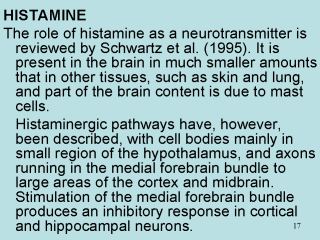| front |1 |2 |3 |4 |5 |6 |7 |8 |9 |10 |11 |12 |13 |14 |15 |16 |17 |18 |19 |20 |21 |22 |23 |24 |25 |26 |27 |28 |review |
 |
Applied
ionophoretically to central neurons, histamine produces either excitatory or inhibitory
effects, via H1, H2 and H3 receptors all of which are typical G-protein coupled receptors. H1- receptors are coupled to phospholipase C, and prodice mainly excitatory effects, whereas H2- receptors act cAMP formation, and are mainly inhibitory. H3- receptors serve as inhibitory autoreceptors on histaminergic neurons. The role of histamine in the CNS is poorly understood. Blocking H1- receptors causes sedation and also has antiemetic effect. |